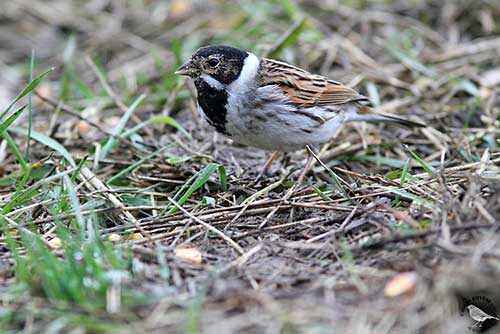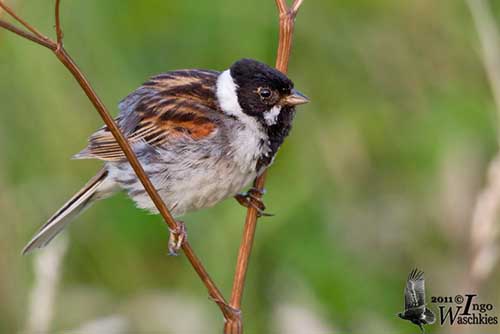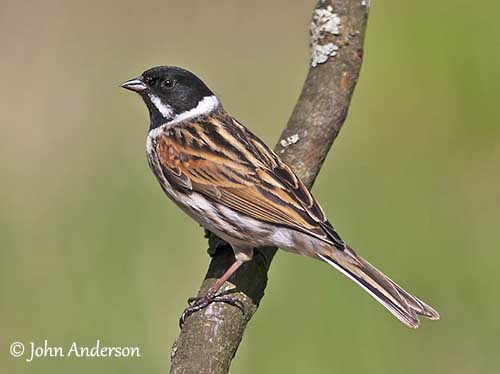
PROTECTION / THREATS / STATUS:
The Common Reed Bunting is usually common or locally common in spite of some declines reported in Norway and Sweden in 1990-2000. Across most of Europe, the populations appear to be stable. However, moderate declines are reported due to drainage of wetlands and use of pesticides in cultivated areas where the birds are feeding after the breeding season.
The total population was estimated in 2004 at 29,400,000/106,000,000 individuals.
The Common Reed Bunting is currently evaluated as Least Concern.
Fr: Bruant des roseaux
Ang: Common Reed Bunting
All: Rohrammer
Esp: Escribano Palustre
Ita: Migliarino di palude
Nd: Rietgors
Sd: Sävsparv
Photographers:
John Anderson
John Anderson Photo Galleries
José Luis Beamonte
Pájaros de España
Didier Buysse
Vision d’Oiseaux
Steve Garvie
RAINBIRDER Photo galleries
Otto Plantema
Trips around the world
Ingo Waschkies
Bird Photography
Nicole Bouglouan
PHOTOGRAPHIC RAMBLE
Text by Nicole Bouglouan
Sources:
HANDBOOK OF THE BIRDS OF THE WORLD Vol 16 by Josep del Hoyo- Andrew Elliot-David Christie – Lynx Edicions – ISBN: 9788496553781
ENCYCLOPEDIE DES OISEAUX DE FRANCE ET D’EUROPE – de Peter Hayman et Rob Hume - Flammarion – ISBN : 2082009920
L’ENCYCLOPEDIE MONDIALE DES OISEAUX - Dr Christopher M. Perrins - BORDAS - ISBN: 2040185607
THE COMPLETE BOOK OF BRITISH BIRDS – Written by “Royal Society for the Protection of Birds” experts - Préface de Magnus Magnusson - Michael Cady- Rob Hume Editors - ISBN: 0749509112
THE HANDBOOK OF BIRD IDENTIFICATION FOR EUROPE AND THE WESTERN PALEARCTIC by Mark Beaman, Steve Madge - C. Helm - ISBN: 0713639601
BirdLife International (BirdLife International)
Muséum national d’Histoire naturelle - Inventaire National du Patrimoine Naturel
Cahiers d’Habitat « Oiseaux » - MEEDDAT- MNHN – Fiche projet
Common Reed Bunting
Emberiza schoeniclus
Passeriformes Order – Emberizidae Family
INTRODUCTION:
The Common Reed Bunting is typically seen perched on reed tops, but it feeds mostly on the ground or in low vegetation in various wetland habitats.
The buntings, and especially the birds of the Old World genus “Emberiza”, have curving, almost S-shaped cutting edges to the mandibles. The small, sturdy bill is typical of the seedeaters. Both mandibles are sharply angled downwards at the base. The lower mandible is often much deeper than the upper mandible. However, the bill shape varies according to the range, the habitat and the diet.
The race “schoeniclus” here described and displayed has one of the smallest bills.
The Common Reed Bunting has decreased in a large part of the range due to drainage of wetlands. But the species was able to adapt to other types of habitats, and since 50-60 years, new drier habitats such as hedgerows and bushes have been colonized.
DESCRIPTION OF THE BIRD:
Biometrics:
Length: 14-16,5 cm
Weight: 19 g
The adult male in breeding plumage has blackish head and throat, and conspicuous white submoustachial stripe. A white hindneck collar extends to the lower sides of the neck.
On the upperparts, the mantle is grey-brown and rufous, streaked blackish. The scapulars are blackish with rufous-edged feathers. Back and rump are greyish with dark streaks, whereas the uppertail-coverts are browner. The deeply notched tail is blackish-brown with extensive white on the outer pair of rectrices. On the upperwing, the red-brown to blackish-brown coverts have slightly paler tips, and the flight feathers are blackish-brown.
The underparts are whitish with variable streaking on breast sides and flanks.
The bill is fairly small and blackish. The eyes are dark reddish-brown. Legs and feet are pinkish-brown.

The adult male in non-breeding plumage has obscured head pattern due to the grey-brown fringes of the new feathers. We can see a buffy-white supercilium. The submoustachial stripe is whitish and the malar stripe is black. The chin is buffish and the throat is whitish.
The upperparts are very similar to breeding plumage on wings and tail, while the rest is slightly paler.
The bill has blue-grey lower mandible.
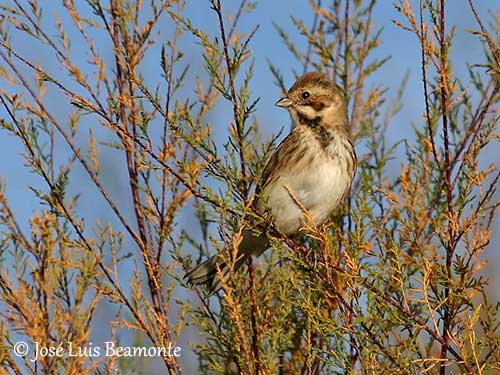
The breeding female resembles non-breeding male with paler nape. The malar stripe is prominent. Breast and flanks are streaked dark. The bill is blackish.
In non-breeding plumage, the female is very similar to non-breeding male with only some difference on crown’s pattern.
The juvenile resembles female, but the crown is mostly chestnut with heavy dark streaking. The blackish malar stripe is broader. The upperparts are yellowish-buff with dark spots and streaks. The breast is heavily streaked whereas belly and flanks are spotted. The eyes are dark grey-brown.
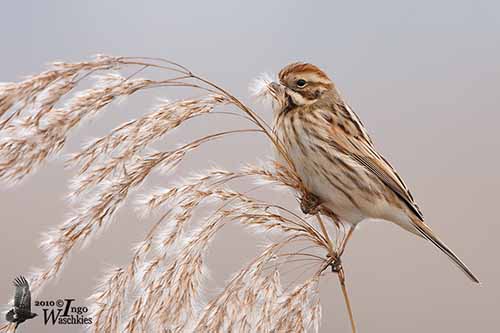
SUBSPECIES AND RANGE:
The Common Reed Bunting breeds across Europe and most parts of temperate and northern Asia. The birds of the milder parts of S and W of the range are usually resident. The other populations migrate S in winter. The birds from N and E of the range winter in N Africa, Iran and Japan.
There are currently 20 recognized subspecies which differ in size and bill size, and details of plumage.
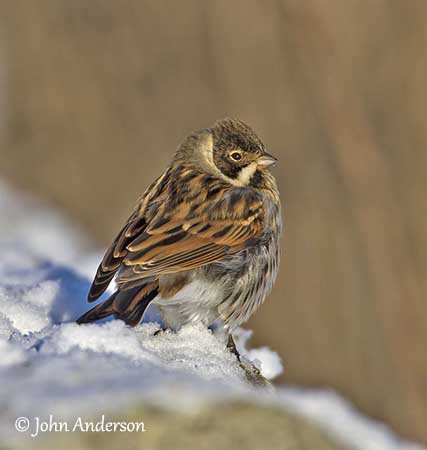
The race “E.s. schoeniclus” is here described and displayed. This race breeds in Europe, from Scandinavia, E to Pechora Basin and Urals, S to British Islands, France, W Austria, N Italy, and across SW Russia. It winters S to N Africa and SW Asia.
HABITAT:
The Common Reed Bunting frequents various wetland habitats such as reedbeds, stands of rushes, wet willow thickets, wet meadows, wet tundra and estuarine saltmarshes.
However, due to intense drainage of wetlands in some parts of the range, this species has adapted to other habitats including cultivated areas and young conifer plantations, hedgerows and bushes, well away from water.
Outside the breeding season, it frequents stubbles, cultivations and coastal grasslands.
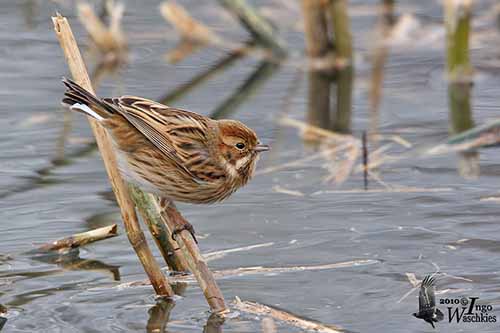
CALLS AND SONGS: SOUNDS BY XENO-CANTO
The Common Reed Bunting’s usual calls are a shrill « tseeu » and a high « see ». We can also hear a deep “chew” or “chup” usually given in flight outside the breeding season.
The song is monotonous, a rising and falling series of 4-5 notes described as “seep-surp-seep-surp-sisssii”.
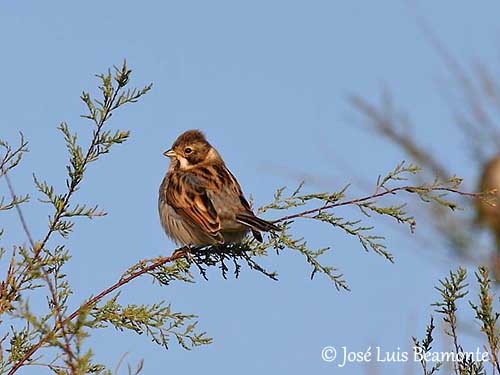
BEHAVIOUR IN THE WILD:
The Common Reed Bunting is usually seen perched on reed tops, although it feeds often on the ground, foraging among the vegetation close to the water, or in cultivated areas during winter. It often forms mixed-species foraging groups with other species such as finches, other buntings, larks and pipits.
During the breeding season, it feeds primarily on invertebrates such as numerous insects and larvae, spiders, snails, bivalve molluscs and crustaceans. But it also takes seeds and plant materials from numerous plant species.
It forages alone or in pairs during the breeding season, and in small groups or loose flocks outside this period.
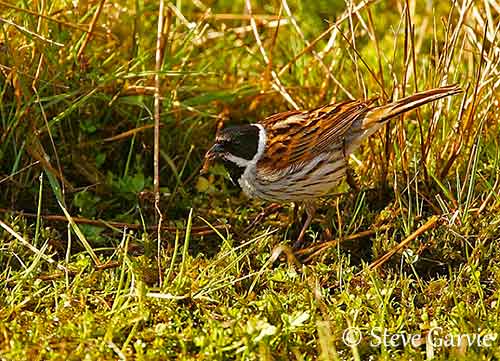
The Common Reed Bunting sings as soon as mid-March to establish the territory and the female builds the nest in early April. It sings from exposed perch with vibrating wings and flicking tail. During this display, the conspicuous black-and-white head pattern is enhanced by adapted postures. They are monogamous.
After breeding, they become more gregarious and small to large flocks may gather at nightime roosts, usually in extensive stand of rushes, and usually close to the water.
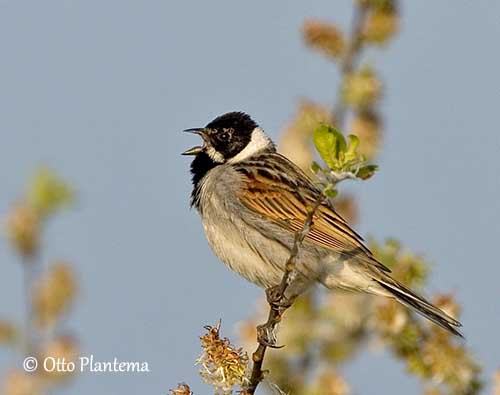
The Common Reed Bunting from the northern parts of the range migrates S and by night for wintering in warmer areas.
The flight is strong and undulating. It is mainly jerky over short distances, but it becomes somewhat whirring and hesitant when well underway.
When flushed, the bird may rise up quite high before diving down into the vegetal cover.
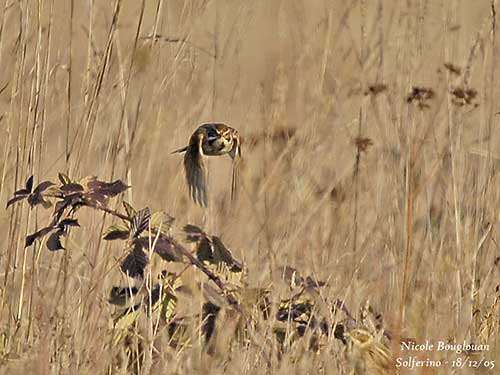
REPRODUCTION OF THIS SPECIES:
The breeding season takes place from April to August, but it may vary depending on the range. This species may produce up to three broods per season.
The female builds the nest usually on the ground, in low tussock or at base of shrub or hedgerow bushes. The cup-shaped substantial structure is made with grass, twigs, moss, sedges, reed stems and leaves. The cup is lined with finer and softer plant materials.
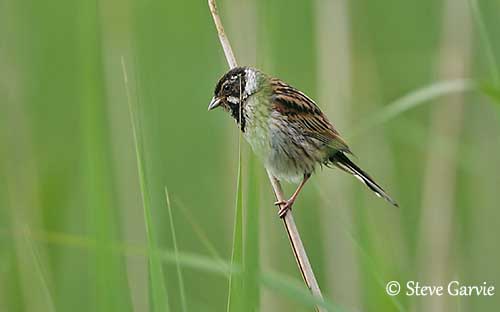
She lays 4-5 olive-grey to pale purple eggs with dark markings. Both adults, but mainly the female, incubate during 12-15 days. The chicks are fed by their parents during 10-12 days. They often leave the nest before to be able to fly.
